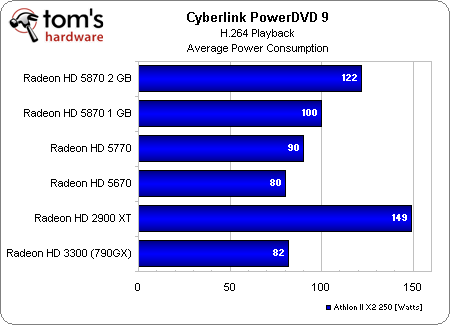AMD's Radeon HD 5000-Series: Measuring Power Efficiency
Most of our graphics card reviews include power measurements at idle and load. But how do applications tax your GPU in between those two extremes? We line up a handful of different programs and monitor power use with a handful of AMD's latest cards.
Benchmark Results: Cyberlink PowerDVD 9
In this test, graphics cards without hardware-based H.264 acceleration must use the CPU to decode video. This explains why the Radeon 2900 XT reports much higher power consumption. All of the Radeon HD 5000-series cards run at higher clocks than idle. But, for the most part, the graphics core isn’t doing much work.
With support for hardware-based video acceleration, modern graphics cards can lower overall power consumption levels significantly. The system consumes around 80 W with the Radeon HD 5670 and 90 W with the HD 5770. As for efficiency, look at the Radeon HD 5670’s results. It has roughly the same power consumption as the integrated Radeon HD 3300, likely due to the similar video decoding block inside the graphics processor.
You can see the difference hardware decoding offers by comparing the two discrete 5000-series cards and the Radeon 2900 XT. With higher idle power consumption and the processor running full speed, the system consumes almost 70 W more power, or almost twice as much.
A mere 20 watts separate the Radeon HD 3300, HD 5670, HD 5770, and HD 5870 1 GB. So, in certain cases, the Radeon HD 5870 1 GB can still save enough power to close in on its more mainstream derivatives. Again, this is the case because the cards use a fixed-function video engine to assist in decoding acceleration, which is the same from one board to the next. Thus, even a high-end card behaves like a lower-end product in such a workload. This is very important, as you will see later on.
The Radeon HD 5870 2 GB draws much more power than the 1 GB version. Too much, in fact. It's about 20 W higher than the 1 GB card. Checking the GPU voltage and measuring idle power draw did not shed any light on this behavior. GPU voltage is the same for both cards, and the HD 5870's idle consumption is only about 5 W higher.
Get Tom's Hardware's best news and in-depth reviews, straight to your inbox.
Current page: Benchmark Results: Cyberlink PowerDVD 9
Prev Page Benchmark Results: Cinebench R11 Next Page Benchmark Results: Cyberlink PowerDirector-
tony singh Very innovative article tom keep it up!! Similar article consisting of various cpus would be really useful.Reply -
spidey81 I know the FPS/watt wouldn't be as good, but what if the 5670 was crossfired. Would it still be a better alternative, efficiency wise, than say a 5850?Reply -
nforce4max Remember the R600 (2900xt) has a 80nm core while the 5870 has a 45nm core. Shrink the R600 and you will get the 3870 (55nm) that barely uses hardly any.Reply -
rhino13 And now just for fun we should compare to Fermi.Reply
Oh, wait, this just in:
There is a Fermi comparison chart that was avalible but you needed to have two screens to display the bar graph for Fermi's power consumption and temperature. So the decission was made to provide readers with the single screen only version.
-
aevm I loved this part:Reply
A mere 20 watts separate the Radeon HD 3300, HD 5670, HD 5770, and HD 5870 1 GB. So, in certain cases, the Radeon HD 5870 1 GB can still save enough power to close in on its more mainstream derivatives. Again, this is the case because the cards use a fixed-function video engine to assist in decoding acceleration, which is the same from one board to the next. Thus, even a high-end card behaves like a lower-end product in such a workload. This is very important, as you will see later on.
My next PC will be used mostly for movie DVDs and Diablo 3. Apparently if I get a 5870 1GB I get the best of both worlds - speed in Diablo and low power consumption when playing movies.
How about nVidia cards, would I get the same behavior with a GTX 480 for example?
-
Onus For those not needing the absolute maximum eye candy at high resolutions in their games, the HD5670 looks like a very nice choice for a do-it-all card that won't break the budget.Reply
Next questions: First, where does the HD5750 fall in this? Second, if you do the same kinds of manual tweaking for power saving that you did in your Cool-n-Quiet analysis, how will that change the results? And finally, if you run a F@H client, what does that do to "idle" scores, when the GPU is actually quite busy processing a work unit? -
eodeo Very interesting article indeed.Reply
I'd love to see nvidia cards and beefier CPUs used as well. Normal non green hdds too. Just how big of a difference in speed/power do they make?
Thank you for sharing. -
arnawa_widagda Hi guys,Reply
Thanks for reading the article.
Next questions: First, where does the HD5750 fall in this? Second, if you do the same kinds of manual tweaking for power saving that you did in your Cool-n-Quiet analysis, how will that change the results? And finally, if you run a F@H client, what does that do to "idle" scores, when the GPU is actually quite busy processing a work unit?
Have no 5750 sample yet, but they should relatively be close to 5770. For this article, we simply chose the best bin for each series (Redwood, Juniper and Cypress).
The second question, what will happen when you tweak the chip? Glad you ask!! I can't say much yet, but you'll be surprised what the 5870 1 GB can do.
As for NVIDIA cards, I'm hoping to have the chance to test GF100 and derivatives very soon.
Take care.
